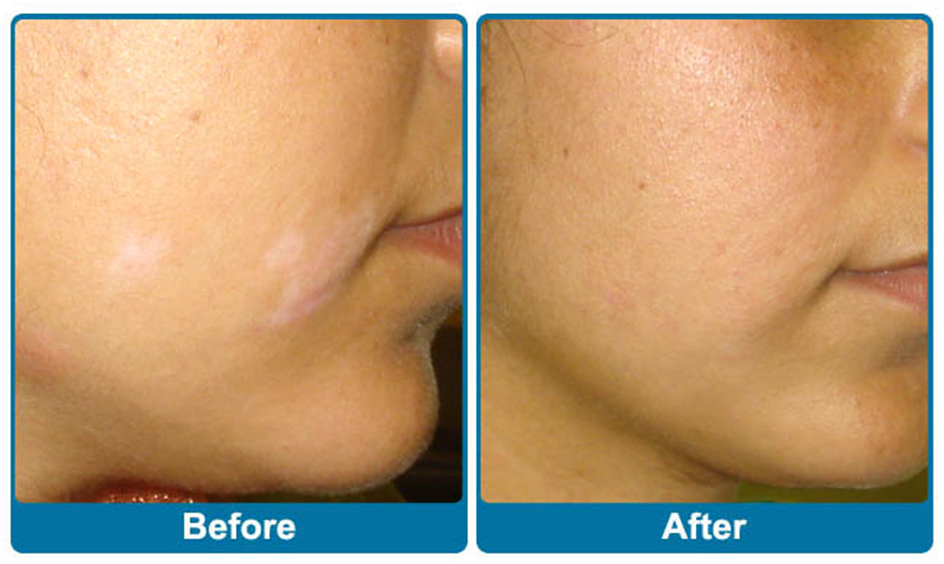Vitiligo

Vitiligo is an acquired, idiopathic, progressive whitening of the skin and hair characterized by destruction of pigment producing cells in the skin called melanocytes.
Vitiligo appears to affect at least 1% to 2% of the population, irrespective of sex, race, or age and 50% begin before age 20. The more dark skinned a person is, the more their vitiligo stands out, because of the contrast between affected and unaffected areas of skin.
People from families with an increased prevalence of thyroid disease, diabetes mellitus, and vitiligo appear to be at increased risk for development of vitiligo. The two predisposing (genetic) and precipitating (environmental) factors contribute to vitiligo.
Many patients attribute the onset of their vitiligo to physical trauma, sun burn, illness, or emotional stress. The typical vitiligo macule is chalk white in color, has convex margins usually present on the extensor surfaces and in priorificial orifices which are typically symmetrical.
The disease progresses by gradual enlargement of individual macules and the development of new white spots on various parts of the body.
Vitiligo can be categorized as one of three types, based on the pattern of depigmentation. The most common type is generalized vitiligo, in which there is widespread distribution of white macules, often in a remarkably symmetrical array.
The focal type is characterized by one or more macules on a single site; in some cases, this may be an early evolutionary stage of one of the other forms of the disease. The segmental type, which is uncommon, is characterized by one of several macules on one hand or one side of the body.
This type is not usually associated with vitiligo macules in other parts of the body, and new vitiligo spots do not appear.
The change in appearance caused by vitiligo can affect your emotional and psychological well-being. You may experience emotional stress, particularly if vitiligo develops on visible areas of you body, such as your face, hands, arms or feet.
You may feel embarrassed, ashamed, depressed or worried about how others will react. Young people, who are often particularly concerned about their appearance, can be devastated by widespread vitiligo.
Find a dermatologist who's knowledgeable about vitiligo. Find out as much as you can about vitiligo and its treatment options so you can participate in making important decisions about your health care.
Vitiligo Surgery
punch grafting
blister grafting
melanocyte culture
Frequently Asked Questions
- What is vitiligo?
- Can vitiligo be curable?
- What is the treatment of vitiligo?
- Is treatment of vitiligo impossible?
- Is oral psoralens, which form the basis for some vitiligo treatments are toxic to the liver?
- Is psoralen + Ultra Violet -A (PUVA) treatments for vitiligo cause cancer of the skin?
- If I have vitiligo, will my children develop it?
- Will the patches reoccur?
- When do a dermatologist advice surgery for vitiligo patches?
Que - 1 : What is vitiligo?
Ans: A depigmenting disease of unknown origin that causes destruction of melnocytes.
Que - 2 : Can vitiligo be curable?
Ans: There is a rapid advancement in the field of treatment for vitiligo. Various treatments, medical and surgical either alone or in combination ranging from topical to systemic medications are available. Appropriate treatment will be planned by the dermatologist depending on your case.
Que - 3 : What is the treatment of vitiligo?
Ans: Though treatment of vitiligo is not very satisfactory, reasonable improvement can be expected in several patients. Treatment depends on age of patient, extent and pattern of vitiligo, cosmetic disabilty and effect on quality of life. A dermatologist will assess and advice appropriate treatment.
Que - 4 : Is treatment of vitiligo impossible?
Ans: This is clearly not true and the majority of patients can achieve good results.
Que - 5 : Is oral psoralens, which form the basis for some vitiligo treatments are toxic to the liver?
Ans: Oral psoralens are not toxic to the liver.
Que - 6 : Is psoralen + Ultra Violet -A (PUVA) treatments for vitiligo cause cancer of the skin?
Ans: When used to treat vitiligo, PUVA therapy requires only a limited number of treatments-approximately 150 in number that has not been shown to cause skin cancer.
Que - 7 : If I have vitiligo, will my children develop it?
Ans: There is no definite mode of inheritance however; siblings may or may not develop. One need not be anxious regarding it.
Que - 8 : Will the patches reoccur?
Ans: Most probably the patches may not reoccur. However in some instances it may reappear. A dermatologist will assess and advice appropriate treatment.
Que - 9 : When do a dermatologist advice surgery for vitiligo patches?
Ans: A dermatologist is going to assess whether a patient is suitable for the surgery. A patch that remains stable for 6 months, site of transplantation and underlying medical conditions.